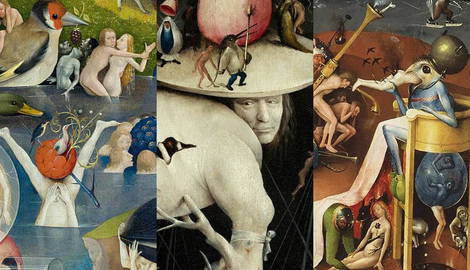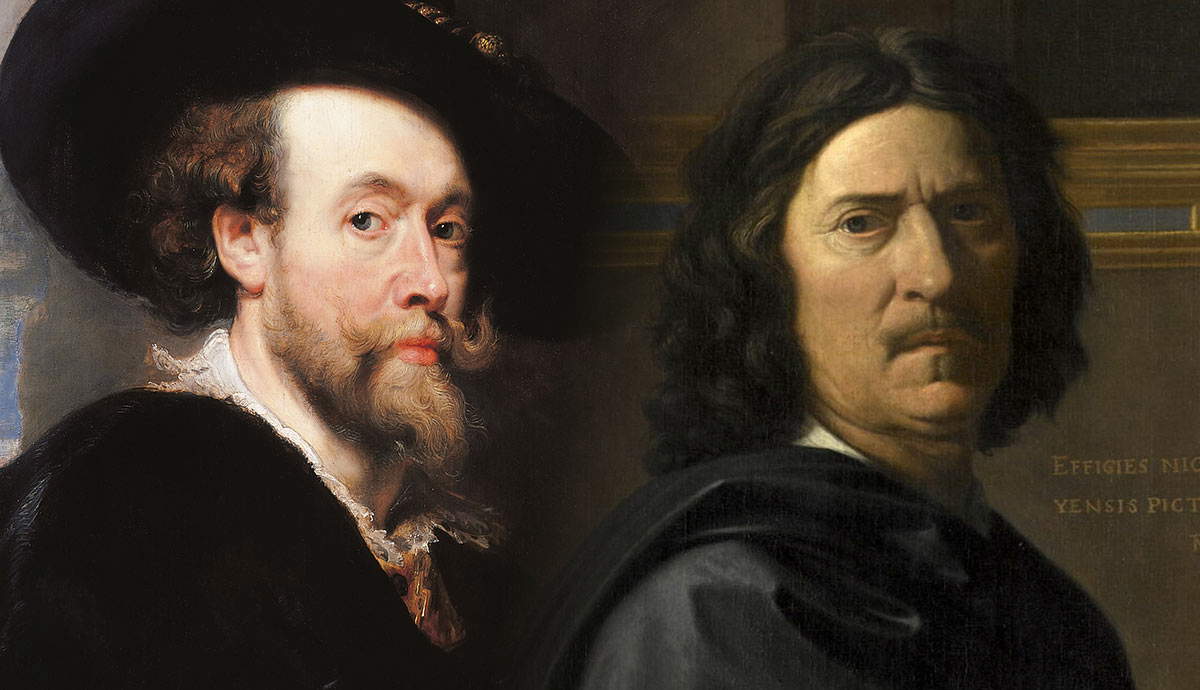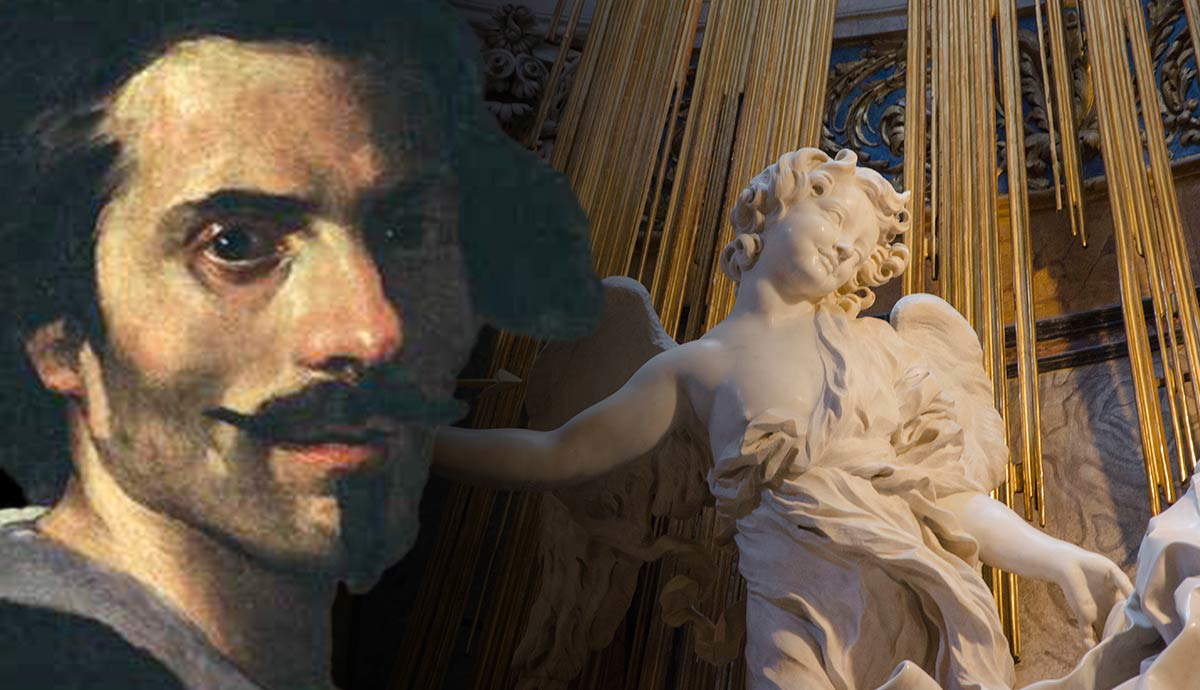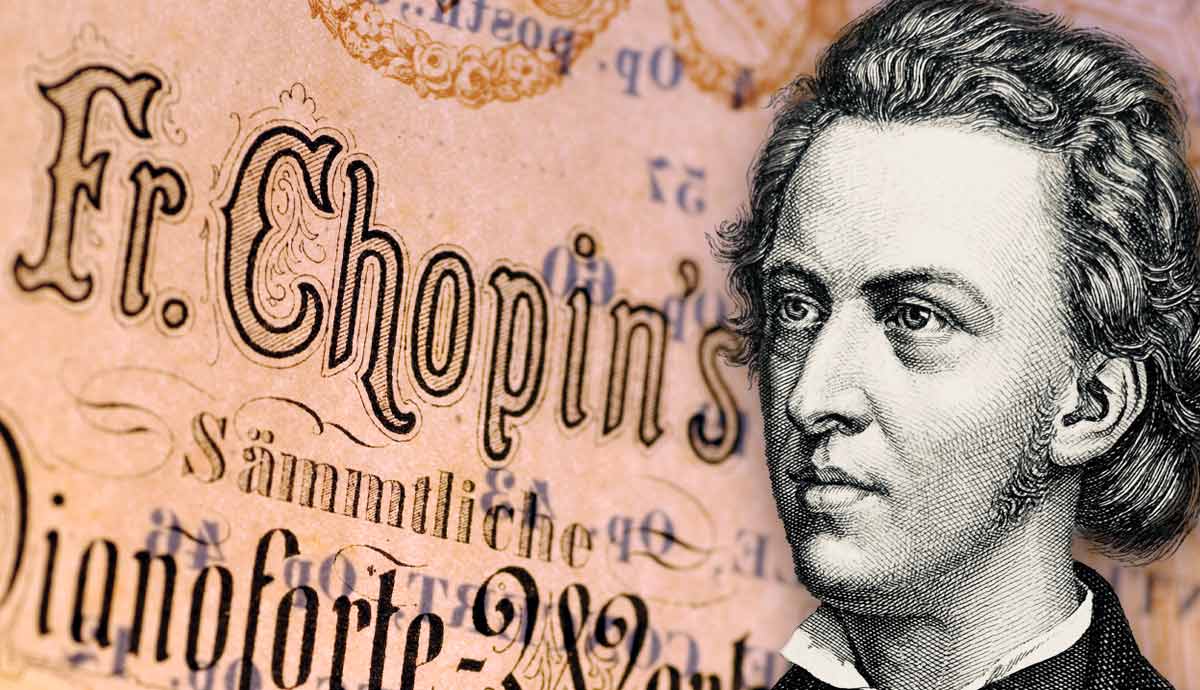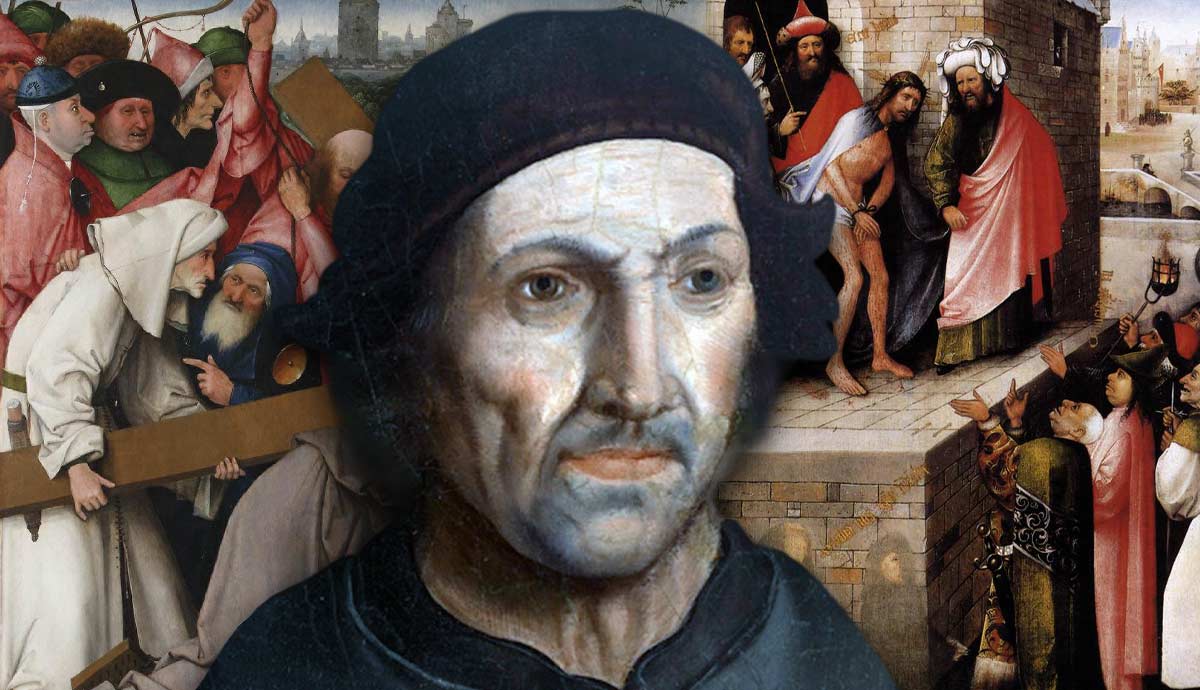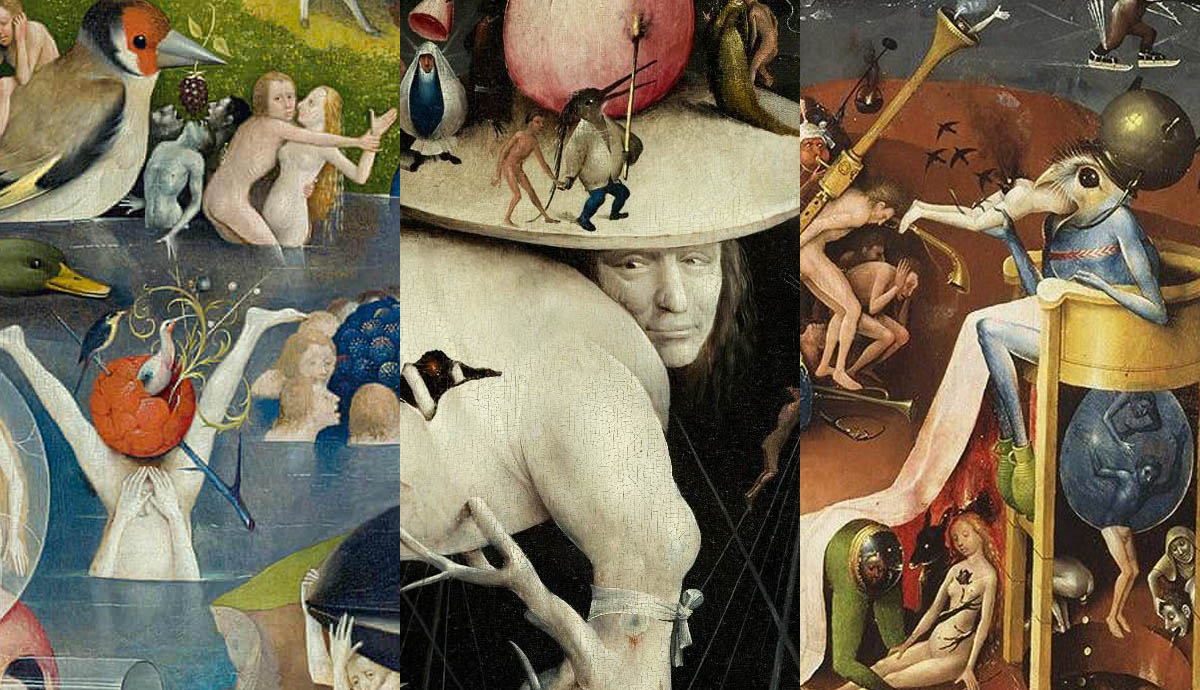
summary
- Hieronymus Bosch was a Dutch painter from the late 15th century.
- His art is known for its fantastical, detailed imagery and religious themes.
- The Garden of Earthly Delights is his most famous work, a triptych.
- His paintings often depict sin, morality, and damnation with unique symbolism.
- Bosch’s style influenced later Surrealist painters, like Salvador Dalí.
Born in the middle of the 15th century, Hieronymus Bosch transformed the world of art. His novel approach to painting shocked and polarized his Dutch contemporaries, and his work soon made its way across Europe, where it continued to divide its audience’s opinions. Read on to find out why Bosch’s masterpieces had such a profound effect.
1. Hieronymus Bosch Was a Painter Unlike Any Other

During the late 1400s and early 1500s, with the High Renaissance playing out in Italy, most artists were striving to replicate nature in their works by using accurate perspective and proportion, lifelike colors, and natural light.
By contrast, Hieronymus Bosch dived headfirst into the fantastical and the abstract. Many of his paintings present apocalyptic scenes of chaos and confusion, packed with symbolic imagery. Humans and animals are shown side-by-side with fictional creatures and freakish monsters; recognizable plants and flowers are distorted in size or color; the laws of physics are utterly defied.
While his contemporaries anchored their paintings in the familiar, Hieronymus Bosch deliberately pursued the extraordinary, forcing his audience to expand their concept of art.
2. Decoding Bosch’s Art Is a Difficult Task

Civic records from Bosch’s native Brabant are sorely lacking and fail even to provide a definitive date of birth. Nor did Bosch himself leave any writings, either published or personal, which could have helped us understand the thought process behind his bizarre and haunting creations.
Moreover, little of Bosch’s work has survived. Although he is thought to have had a prolific career, only 25 paintings remain, and many of them are in fragments. Along with these, there are around 20 drawings that help to provide more insight into the artist’s style and methods.
The minimal information available about Bosch’s life means that we must look more deeply into his artwork to try and fathom what inspired him.
3. His Most Famous Masterpiece Is Also His Most Confusing

The best-known of Hieronymus Bosch’s paintings is undoubtedly The Garden of Earthly Delights. Produced from 1495 to 1505, The Garden is actually a triptych made up of distinct but complementary panels. The inner view shows the entire timeline of humanity in three stages: the Garden of Eden, earthly life, and the Last Judgement. When closed, the triptych represents the world after the third day of creation. These topics were far from new in Western art, but they had never been portrayed like this.

The three panels feature the typical exotic animals and plants of the earthly paradise, people engaged in various activities, and the terrifying punishments of the day of judgement. However, Bosch’s style gives all these scenes and figures a nightmarish quality.
The buildings are an undefinable amalgam of the natural and the artificial. The creatures are combinations of recognizable animals and monsters, and the human figures are all naked and warped in a number of confusing positions and poses.
The effect of these bizarre features is almost hallucinogenic. They create an uncanny and surreal atmosphere in which everything can be identified, but nothing can be understood.
4. Bosch’s Masterpiece Is Packed With Layers of Symbolism

Although many of its symbols and motifs defy explanation, some of the imagery that appears in The Garden can help to explain the meaning behind Bosch’s masterpiece.
In the first panel, for example, rabbits represent fertility and fecundity, while snakes and mice were commonly used as phallic symbols. Lust is also represented by the strawberries (center panel), as well as the musical instruments in the third panel, particularly the flute sticking out of a man’s behind!
The various birds and beasts that populate the painting’s landscapes, including giraffes, elephants, and lions, were then held as hallmarks of the exotic. Bosch may have based his depiction of these animals on contemporary travel writing to evoke ideas of the wild, far-away lands of Asia and Africa. Additionally, it has been suggested that the cherries, precariously balanced on the head of a woman in the center panel, are a symbol of pride.

The majority of the symbolic elements in the painting all point towards the idea of indulgence, pleasure, and sin. This has led scholars to conclude that The Garden of Earthly Delights, with its explicit and striking imagery, was never intended to be displayed in a church. Instead, it is thought that the triptych was a private commission, made to show off the owner’s wealth and worldliness.
5. Bosch’s Art Explores Human Concerns

Hieronymus Bosch’s work forces us to contemplate the complex nexus between life and death, right and wrong, good and evil.
The Garden of Earthly Delights illustrates the pitfalls humanity has to face in the material world, where morality and righteousness can easily be displaced by pleasure and indulgence. Read from left to right, the triptych tells the story of humanity’s fall from grace, overcome by the temptations of earthly delights.

Similarly, The Seven Deadly Sins and the Four Last Things, which Bosch painted during the same period, show the consequences faced by the faithful who stray from the path shown by God. The seven sins are portrayed in the central circle: wrath (at the bottom), envy (clockwise), greed, gluttony, sloth, lust, and pride. The Four Last Things that await humanity at the end of life (death, judgment, Heaven, and Hell) are shown in the other four small circles.
6. Bosch’s Paintings Reveal Something About His Religious Beliefs

Hieronymus Bosch grew up in the city of Den Bosch, the monastic center of the Duchy of Brabant; it has been estimated that, during Bosch’s lifetime, 5% of the population was made up of monks or nuns. Bosch himself is recorded as a member of the Illustrious Brotherhood of Our Dear Lady, a religious order dedicated to worshipping the Virgin Mary.
Bosch’s religious belief underlies his work, which can be seen as a warning against the excesses and indulgences condemned by Christianity. Indeed, his paintings aim to demonstrate the destructive nature of worldly pleasures, showing how they lead to eternal punishment.
More specifically, art historians have noted that Bosch’s paintings seem to emphasize the culpability of women. It was a common idea at the time that women tempted men into a life of sin.
This view was shared by the Dutch artist. In the central panel of The Garden of Earthly Delights, women appear to be seducing, beguiling, and even attacking men. Even the plants and flowers in the paintings have been said to represent femininity, suggesting that the lure of the feminine distracts from the path of righteousness.
7. Bosch’s Paintings Might Also Reflect Real-Life Experiences

One character that appears again and again in Bosch’s paintings is St Anthony, depicted as a hermit-like figure in a brown robe. St Anthony was tempted by demons, which gave Bosch the opportunity to paint yet more monstrous creatures, and gave his name to a condition then known as ‘St Anthony’s Fire.’
Those affected by this condition would experience fevers, seizures, and hallucinations, which sometimes led to their admission to insane asylums. One such institution was located in Bosch’s hometown. Thus, it is possible that his surreal and supernatural paintings may have been inspired by the hallucinations of some inmates.
Bosch’s artworks may also have been impacted by a huge fire that caused untold destruction in his hometown during his early years. Many of his paintings show buildings alight. While they have been thought to symbolize apocalyptic annihilation, perhaps they simply recall the experiences of a young boy watching his neighborhood burn.
Another source of inspiration may have come from his family. While in his early 30s, Bosch married a woman whose parents owned a pharmacy. In their shop, he would undoubtedly have come across many of the instruments and apparatus that would later appear in his paintings. The Garden of Earthly Delights, for example, features several glass vials and cylinders, which imply experimentation and scientific curiosity.
8. His Novel Style Immediately Attracted Interest

The municipal records of Hieronymus Bosch’s death show that, by 1516, he had already become a ‘very famous painter.’ Indeed, his artwork immediately garnered attention from his contemporaries, attracting praise and condemnation in equal measure.
Only a year after the artist’s death, The Garden of Earthly Delights was on display at a palace in Brussels. Here, it was viewed by a number of important diplomatic figures. Some of them were enchanted by its whimsical and bizarre approach. However, others were affronted, considering the masterpiece an insult to both art and religion.
The Garden was also reproduced numerous times (even in tapestries), which allowed Bosch’s work to circulate more widely. This may have been how it came to the attention of Philip II of Spain, who subsequently became a great collector of Bosch’s paintings. Many of them are still kept in Madrid at the Museo del Prado.
9. Many Tried to Copy Bosch’s Unique Style

Although Bosch did not leave a large workshop or school, he nonetheless had a number of notable followers who attempted to emulate his remarkable style. Among these was Pieter Bruegel, who also evoked themes of chaos and disorder in his own depictions of the human experience.
In the 15th century, the Italian Mannerist painter Giuseppe Arcimboldo was inspired by Bosch’s uncanny designs. Like Bosch, he twisted nature, using plants and other organic matter to build intriguing and complicated images in his famous ‘vegetable portraits.’
Both Bruegel and Arcimboldo were inspired by the way in which Hieronymus Bosch combined the natural and the synthetic to create a disconcerting impression that borders between uncertainty and familiarity.
10. Hieronymus Bosch Inspired Surrealism

Although he preceded them by many centuries, Hieronymus Bosch is widely credited as the first artist of the Surrealist movement. Rather than simply depicting everyday reality, Bosch brought together the physical and the metaphorical, the natural and the supernatural, the familiar and the alien.
At the dawn of the 20th century, his style would be rediscovered by the likes of Joan Miro, Salvador Dalí, René Magritte, and Max Ernst. Also drawing inspiration from Freud’s concept of the uncanny, these Surrealist artists’ work shows a fascination with fantasy, the unbridling of imagination, and indulgence in the unreal.
As a Spaniard, Dalí had seen Bosch’s work firsthand at the Museo del Prado, and many of his own paintings are indebted to Bosch’s in composition, form, and color. The Great Masturbator, for instance, contains remarkable similarities to part of the left panel of The Garden. This demonstrates just how much the legacy of Hieronymus Bosch has continued to grow, develop, and inspire across half a millennium.
